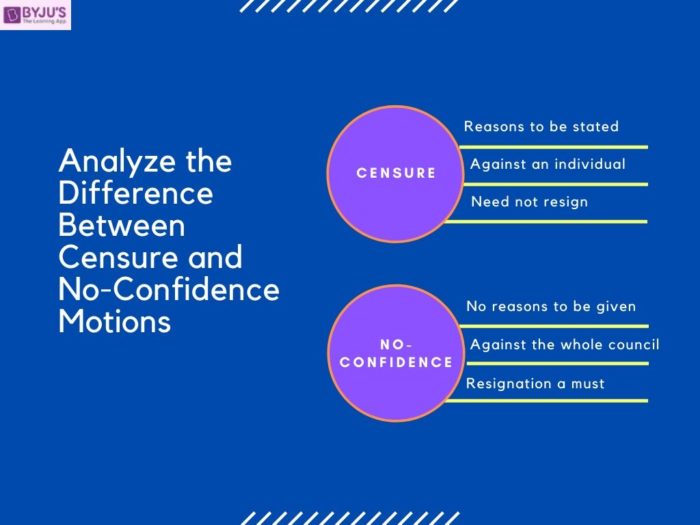Censure and No-Confidence motions are two devices of parliamentary proceedings which are used by the members of Parliament to act according to the rules of the houses. Other than this similarity the two terms are different from each other.
A censure motion can be moved in the parliament or in a state assembly in India. It is moved by the opposition against a specific policy of the government or against a minister or against the whole council of ministers.
A No-Confidence expresses a lack of confidence in the current set up run by the Prime Minister and the council of ministers, if passed in the parliament, then the entire ministry will have to resign.

This article will further highlight the difference between censure and no-confidence motion for the IAS Exam
Aspirants can find more Difference Between Articles, by visiting the linked page
The differences between censure and no-confidence motions are given in the table below:
Differences between Censure and No-Confidence Motion
| Censure |
No-Confidence Motion |
| The reasons for the adoption of a censure motion in the Lok Sabha must be stated | No reasons for its adoption must be stated in the Lok Sabha |
| The censure motion can be passed against an individual minister, a group of ministers, or the entire council of ministers | A no-confidence motion can be passed against the entire council of ministers only. |
| It is moved for censuring the council of ministers for specific policies and motions | It is moved for ascertaining the confidence of the Lok Sabha in the council of ministers |
| No one from the council of ministers needs to resign if the motion is passed in the parliament | If it is passed in the Lok Sabha the entire ministry including the prime minister must resign from office |
| Actions of individual members can only be censured | Article 75 of the Constitution of India states that the council of ministers is collectively responsible to the Lok Sabha as long as it enjoys the confidence of a majority of the members of the house. |
Censure and no-confidence are important concepts in the polity segment of the UPSC 2022 exam. The following links will be of immense use to candidates in their exam preparation:
- Indian Polity Notes for UPSC
- Polity Syllabus and Strategy for UPSC Exams
- Majorities in the Indian Parliament
- Functions of the Parliament
- Rajya Sabha
- Difference Between Written and Unwritten Constitution
- Difference Between Constitution and Law
- Difference Between Legislative and Executive
Difference Between Censure and No-Confidence Motion – Download PDF Here
Frequently Asked Questions about Censure and No Confidence Motion
What is motion to censure?
When is a no confidence motion passed in India?
Candidates can find the general pattern of the UPSC Exams by visiting the UPSC Syllabus page. For more articles and exam-related preparation materials, refer to the links given in the table below:
Related Links


Comments